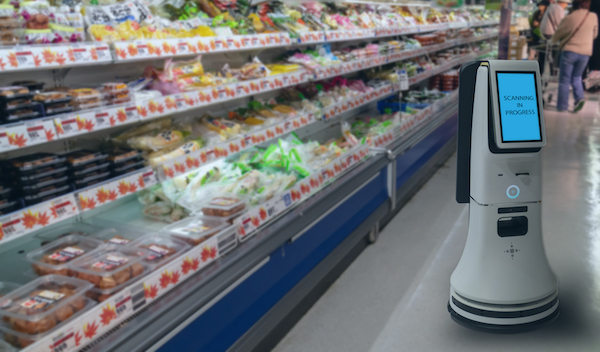Robotic systems have made their way into retail, from 6-feet machines catching spills at Giant Foods Stores to automated shelf-scanners monitoring inventory in Walmart. In many Lowe’s stores, a “LoweBot” can answer simple questions, such as where to find certain things, and assist with stock management. These robots relieve staff of routine duties, ostensibly providing humans more time for consumer connection—but that’s just the beginning.
Probably the most significant benefit of retail bots is the ability to collect more specific data about the products on the shelves and customers’ buying patterns, improving inventory management efficiency and accuracy. The best approach is to use retail robots as analytic tools within an internet-of-things (IoT). IoT offers an advanced digital infrastructure in industries ranging from manufacturing to aviation and now retail. When coupled with potent machine vision capabilities, IoT is helping to push the 4th Industrial Revolution.
Retailers already have the ground of a comprehensive IoT solution laid with the deployment of robots in their stores. For example, Auchan Retail Portugal S.A., a prominent European grocery retailer, is introducing automated shelf-monitoring bots in its hypermarkets. While moving around the stores, these robots capture images of every aisle and shelf, subsequently digitized and processed into data about out-of-stock products and pricing.
In retail, where knowing and anticipating consumer demand is critical, such granular data is highly valuable. For example, Stitch Fix—an online personal styling service—emphasizes machine learning in many aspects of its business strategy, from product discovery to inventory management to design. On the other hand, traditional retailers recognize that simply tracking what customers buy does not provide a clear picture. The true competitive edge for retailers comes from knowing what customers wanted to buy but couldn’t. This is where aisle robots come into the picture.
Data Collection at the Top of the Sales Funnel
Robots that patrol retail stores collect data based on what is on the shelves and what isn’t. Their constant scans provide a complete picture of their customers’ shopping experiences. Shelf inventories, for example, reveal what’s in abundant supply, what’s running low, and what’s out of stock—all of which reflect consumer preferences and behavior.
Robots may be able to do more than just report on inventory levels and do pricing checks to maintain accuracy and consistency in the not-too-distant future. Consider the following hypothetical situation: a retail bot scanning grocery store aisles detects that the stock of Marshmallow Froot Loops are depleting at twice the rate of regular Froot Loops. This real-time detection prompts an automated order for more Marshmallow Froot Loops to be delivered to a specific retailer.
This swift response without human intervention is important. The money to be made right now for retailers is in avoiding any inventory anomalies that lead to out-of-stocks, which have a hefty price tag—a staggering $1 trillion globally. Empty shelves leave customers disappointed, which leads to decreased shopper loyalty in addition to lost sales.
IoT Can Benefit Other Industries
In other industries, such as airlines, early detection of low inventory can help enhance productivity and customer experiences. Unforeseen aircraft repairs, for example, can cause flight delays not just because of the urgent need to perform a repair but also because the required part is often not handy. Using an IoT model for airplane maintenance would result in better inventory control and more potential for the airplane to flag a need for repair or replacement before the plane is taken out of service.
IoT solutions, coupled with machine vision tech, are already being used for predictive modeling and maintenance in applications ranging from manufacturing to water systems.
For years, bots have made strides into a broad array of industries, from auto manufacturing to warehouse robotic systems that lift heavy objects. Robots also handle bags and serve as digital concierges at some hotels. Due to the COVID-19 pandemic, robots have lately entered healthcare facilities to perform nonsurgical tasks such as sanitizing and disinfecting halls and rooms and carrying medical supplies to the lab. Cleaning bots are also pushing their way into commercial settings ranging from corporate buildings to airport terminals.
Rethinking Retail
Retailers must continue to rely on innovative solutions to define themselves and increase their survival odds in this hypercompetitive industry, where margins are stretched across brick-and-mortar, online, and omnichannel players. E-commerce was one of the first waves of retail innovation. While not a new concept, e-commerce did make further advances due to the pandemic, as more buyers decided to stay home and purchased online more frequently. In fact, the pandemic may have sped up the transition from physical to digital commerce by up to five years.
Retail visionaries have also revisited the idea of “brick-and-mortar” to present products and provide consumers with the option to experience new product offerings. Now, retailers are delving deeper into IoT to improve inventory management and predictive modeling as the latest steppingstone to more significant innovation.
As product cycles shrink, merchants must become even more nimble to recognize consumer preferences microtrends to deliver what customers need. The key to it all could be a free-roaming robot collecting data from the aisles and shelves and sending it into the cloud-based data management system.
Let Universe Kogaku’s lens application engineers supply you with the best lens solution.
Universe Kogaku has a highly skilled engineering team capable of designing and manufacturing optical lens assemblies for many robotic and machine vision system applications. If you need premium custom lenses to boost the efficiency and profitability of your retail operations, please get in touch with us at 1-516-624-2444 or info@universeoptics.com. One of our trained lens application engineers will get back to you as soon as possible.
